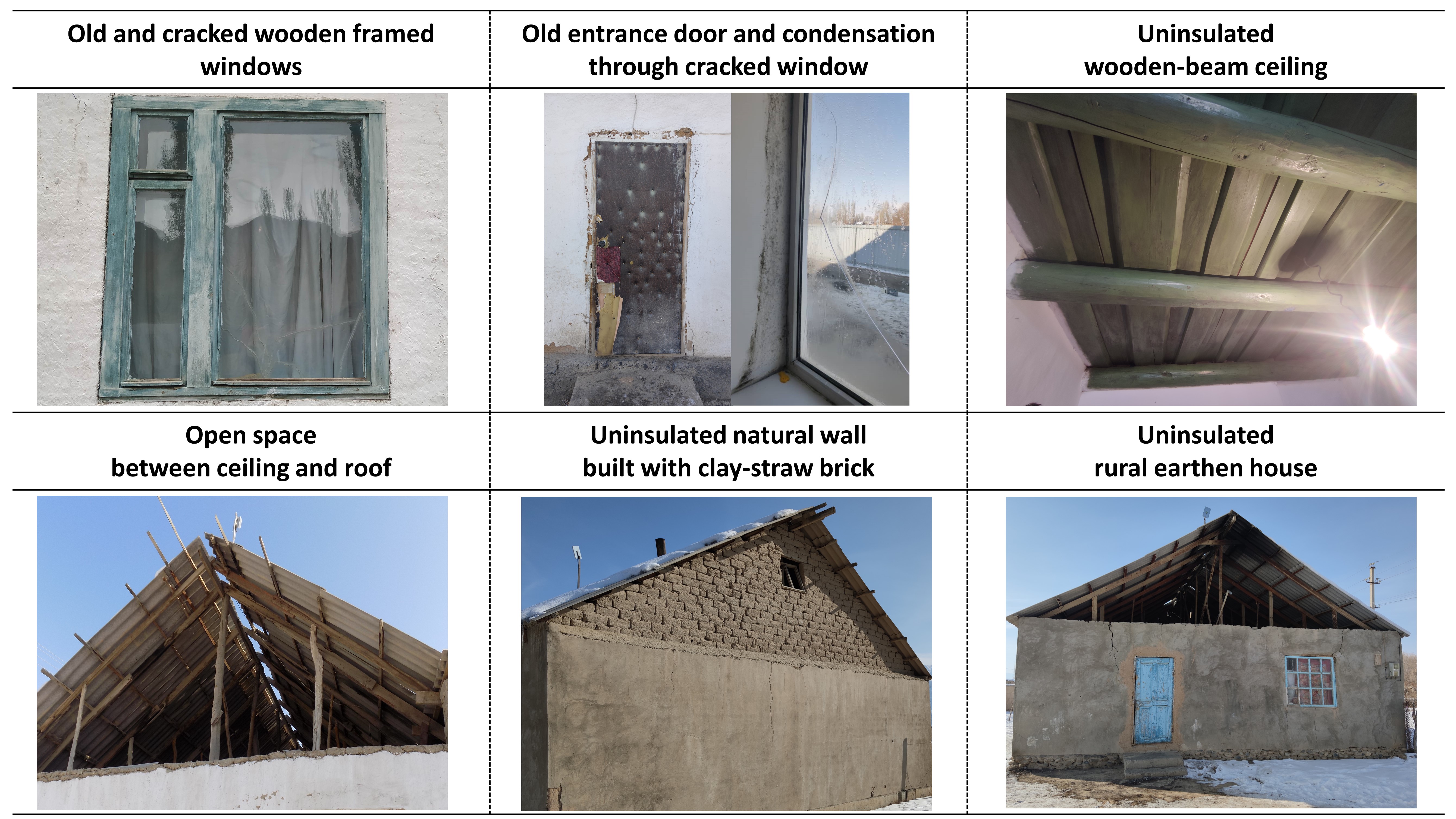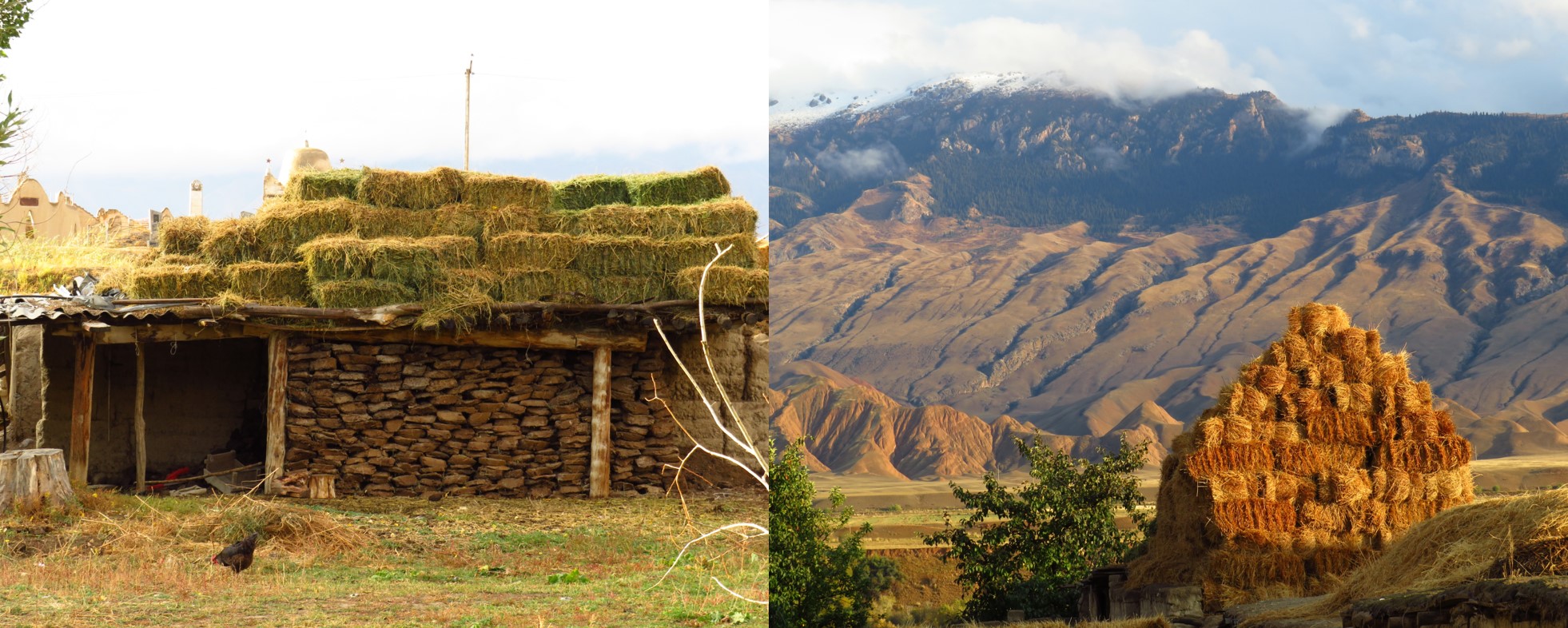

ÖkoFlussPlan: Sequential roadmap to reduce residential space heating demand of rural Kyrgyz house
Because of the mountainous and high-altitude characteristics, Kyrgyzstan’s climate is characterised as sharp continental with a long and harsh winter (-20 to -30 °C in the mountainous areas). The cold and extended winter in the country defines house heating as a primary need for Kyrgyz people.
To identify the energy supply and consumption trend, the on-site household survey was performed in the Ak-Tal region in close cooperation with the Naryn State University. From the field visit, it was identified that most of the rural homes were constructed during the Soviet era (30-40 years ago). A typical rural house has natural walls with a thickness of 0.35 m to 0.50 m without any insulation. The uninsulated earthen floor is constructed with wooden beams and floorboard with a total thickens of 0.20 m to 0.40 m. Similar to the floor, the ceiling consists of a wooden beam structure and open space under the roof. Further to this, the installed windows in the houses were mostly cracked and exposed to air leakages. This typical building profile is partially applicable to most rural communities as families assist each other with house construction and transfer the knowledge of building styles. Therefore, the housing profile in most rural communities is relatively homogeneous in Kyrgyzstan.
The age of the residential buildings, poor housing conditions and the absence of proper thermal insulation result in both high heat demand and low thermal comfort in rural Kyrgyz houses. The simulation study identified that the typical energy consumption per square meter of uninsulated / vernacular Kyrgyz houses (290-320 kWh/m2) is almost 2-3 times higher as compared to the European houses (100-120 kWh/m2) because of the inappropriate building structures.

As the district heating system is concentrated in the capital city and nearby urban areas, most rural households resort to individual traditional heating solutions fuelled by non-sustainable solid fuels (i.e. coal, firewood, wood branches, cow-dung etc.). It was assessed from the on-site visit that during the winter period (from October to March), based on the availability of heating fuels and financial capabilities, the average rural family needs to use 2 to 4 tons of coal, 1.5 to 3 m³ of firewood and 1 to 2 truckloads of cow-dung to meet high residential heat demand.
The excessive wood collection by rural communities leads to a negative impact on the riparian forests and the use of obsolete traditional heating stoves to burn non-sustainable solid fuels induces indoor and outdoor air pollution. In this respect, improving the energy efficiency factor of rural Kyrgyz houses plays an imperative role to reduce domestic space heating demand.
From the survey, it was examined that the majority of the rural population engage in forestry and livestock husbandry, which are seasonal and therefore don´t yield a constant income throughout the year. Because of the low-income scenario, people cannot afford typically efficient synthetic insulation materials such as fiberglass, polystyrene, polyurethane (generally industry processed). In addition to that, the industry-processed insulation materials are not easily available in rural areas because of their remote locations. On the contrary, agricultural resources (i.e. straw-bale, reed, sheep wool etc.), which are widely and locally available in rural Kyrgyzstan, can be utilised to develop economically feasible insulation structure.

The survey results recapitulate that it is difficult to apply energy efficiency parameters (i.e. leak-proof windows, insulated building envelope, reduces thermal bridges etc.) at once for rural people due to limited income. Hence, it is essential to have a suitable hierarchy to reduce residential space heating demand in segmentation by considering the local boundary conditions such as low-income scenario, available sustainable natural resources for insulation, cold climate. To accommodate that need, THI proposed a sequential roadmap by providing various options to reduce heat demand based on the simulation studies. This study includes the several solutions starting from improving building envelop to insulate the whole house to abbreviate the domestic space heating demand.

The results summarised that the installation of proper double-paned PVC windows can help to reduce the total heat demand by 10 %. Naturally, the open space between the ceiling and roof induces considerable heat loss during winter days. The closing of the open roof leads to a dropdown in the total heat demand by 20 %. Indeed, the introduction of insulation to Kyrgyz buildings plays a vital role to reduce the space heating demand. The application of sustainable insulation layers (straw-bale) to walls and ceiling can significantly influence heat demand and total thermal load can be reduced by 30 % according to house size and building construction quality. While insulating the floor, walls and ceiling together with straw-bale can diminish the heat demand by 70 %. The presented idea can be adopted by existing low-income rural Kyrgyz habitations to reduce the residential heat load sequentially to overcome financial barriers and therefore contributes to establishing sustainable buildings in rural areas of Kyrgyzstan. Also, these results can be partially transferable to the other Central Asian rural communities based on the location and building characteristics.
